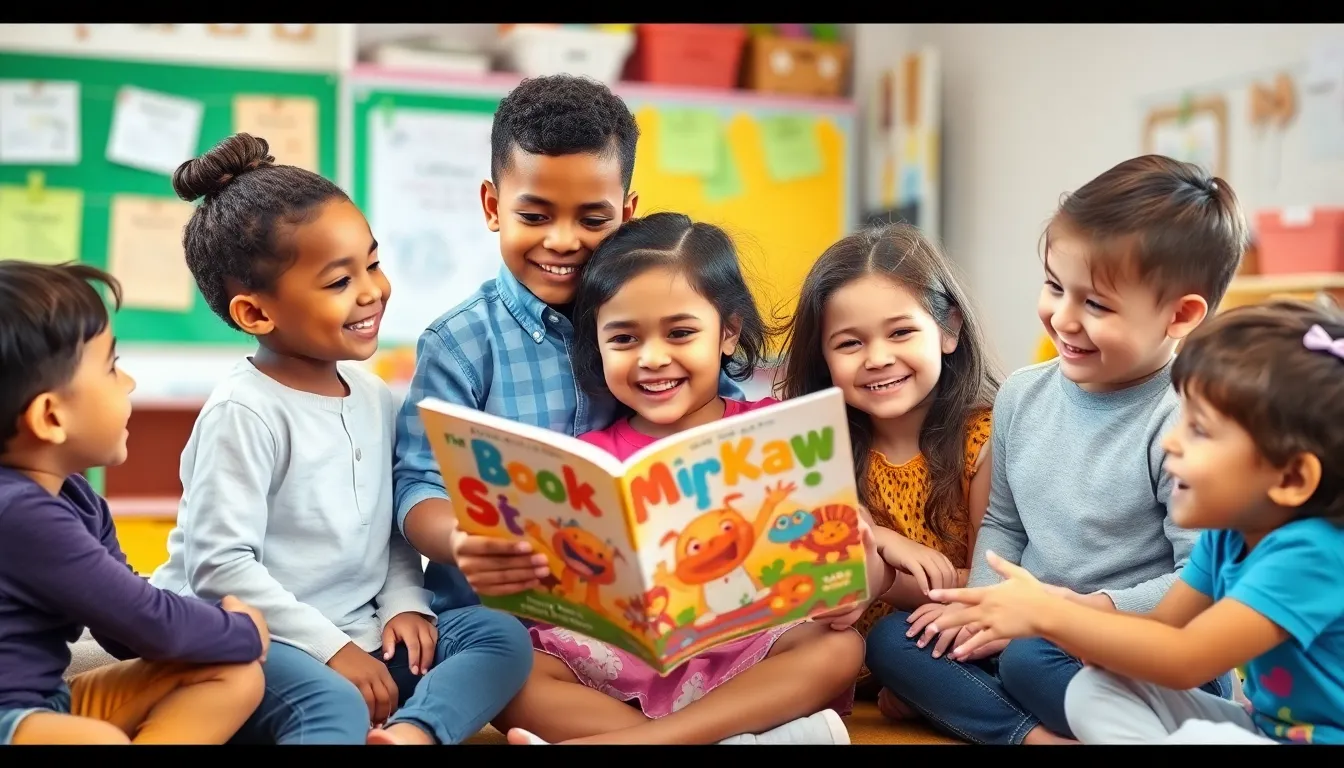Table of Contents
ToggleLiteracy development isn’t just a fancy term thrown around by educators; it’s the magical journey every child embarks on, often with a crayon in one hand and a storybook in the other. From scribbles to sentences, these five stages of literacy development are like the five stages of grief, but way more fun and way less sad.
Overview of Literacy Development
Literacy development involves a series of stages that children pass through as they learn to read and write. Understanding these stages provides insight into how children acquire essential literacy skills. The progression begins with early scribbles, where a child experiments with writing. During this phase, children express their thoughts through marks on paper, which lays the foundation for more complex writing.
Following early scribbles, children enter the stage of letter recognition. They learn to identify letters and their corresponding sounds. This stage is crucial, as it helps form the basis for decoding words. Familiarity with letters enables children to begin sounding out simple words, enhancing their reading skills.
Next, children progress to the word stage, where they start to recognize whole words. They can read familiar words and may begin to practice writing them. Fluency at this stage varies, yet it marks a significant step toward confident reading and writing.
The fourth stage focuses on sentences. Children begin to understand sentence structure and how to convey complete thoughts. Writing sentences becomes more common, and reading fluency improves, allowing for better comprehension of texts.
Lastly, the advanced stage involves storytelling and more complex writing. Children learn to organize their ideas and develop narratives. They can express themselves creatively and analyze different texts, showcasing the literacy skills they have developed throughout the process.
Each stage of literacy development plays a vital role in shaping a child’s abilities. Recognizing these stages helps educators and parents provide appropriate support to foster a love for reading and writing.
The 5 Stages of Literacy Development

Literacy development consists of five distinct stages that shape children’s reading and writing abilities. Each stage builds upon the previous one, facilitating a comprehensive understanding of literacy skills.
Stage 1: Emergent Literacy
Emergent literacy marks the initial phase of literacy development. Children engage in scribbling and creating shapes, expressing thoughts through marks. This exploration encourages them to develop fine motor skills. Through play-based activities, they encounter books and storytelling, fostering an appreciation for language. Interacting with caregivers during reading time boosts their vocabulary acquisition. Young learners begin to understand that written symbols represent sounds, setting the foundation for future literacy skills.
Stage 2: Early Literacy
Early literacy involves recognizing and producing letters. Children learn the alphabet and associate sounds with each letter, significantly enhancing their decoding skills. Practicing letter formation through tracing or writing strengthens fine motor skills. Engaging with simple texts introduces sight words and repetitive phrases, increasing their confidence. Group reading sessions allow young learners to share stories, encouraging discussion about the content. With these experiences, children increasingly connect letters to their corresponding sounds.
Stage 3: Developing Literacy
Developing literacy signifies a transition to recognizing and writing whole words. During this stage, children gain fluency in reading simple texts. Vocabulary expands as they explore stories independently or with guidance. Writing short sentences becomes more common, allowing them to articulate ideas clearly. Teachers often introduce word families to support their understanding of spelling patterns. Story-related discussions help students enhance comprehension skills, making reading a more interactive process.
Stage 4: Consolidated Literacy
Consolidated literacy emphasizes understanding sentence structure and reading fluency. Children begin to write paragraphs, organizing their thoughts coherently. They often explore various text genres, including fiction and nonfiction, broadening their reading experience. Reading comprehension strategies are introduced, promoting deeper analysis of texts. Collaborating on group projects encourages critical thinking and enhances their enjoyment of literature. These skills pave the way for more advanced writing and reading tasks.
Stage 5: Proficient Literacy
Proficient literacy reflects a mastery of reading and writing skills. Students engage with complex texts, analyzing themes and author techniques. They produce detailed reports and narrative pieces, showcasing their ability to express complex ideas. An extensive vocabulary supports their writing, enabling them to convey precise meaning. Flexible thinking allows them to adapt writing styles based on audience and purpose. Students at this stage develop a love for reading, often exploring diverse literature independently.
Importance of Understanding Literacy Stages
Understanding literacy stages is crucial for fostering effective teaching strategies. Educators can tailor instruction to match each child’s developmental level. Identifying where a child stands in their literacy journey allows for targeted interventions that promote growth.
Recognizing literacy stages helps in nurturing a child’s love for reading and writing. Engaging children at their specific stage encourages exploration, creativity, and confidence in their skills. This awareness aids parents in selecting appropriate reading materials and activities that align with their child’s abilities.
Each stage of literacy development has characteristics that signal needed support. For example, during the Emergent Literacy stage, simple play-based activities enhance fine motor skills. In the Early Literacy stage, engaging with the alphabet fosters sound recognition.
Monitoring progress through these stages provides insights into a child’s overall literacy health. Teachers can use this information to devise strategies that address individual needs. Continuous assessment proves essential for adapting teaching methods to suit evolving literacy skills.
Literacy stages serve as a roadmap for teachers and parents alike. By understanding the key milestones, care providers can celebrate achievements and set new goals. This proactive approach cultivates a supportive environment that encourages lifelong reading habits.
Recognition of these developmental stages significantly impacts educational outcomes. Each stage builds on the previous one, forming a solidfoundation for sophisticated literacy skills. Without this understanding, children may miss out on critical learning opportunities necessary for academic success.
Strategies to Support Each Stage
Supporting literacy development at each stage requires targeted strategies. For Emergent Literacy, caregivers can provide various writing tools, such as crayons and markers, encouraging free expression through scribbles. Engaging children in storytime fosters connections to language, making reading enjoyable.
During the Early Literacy phase, using letter games and flashcards enhances recognition. Singing songs that emphasize letter sounds aids in associating letters with their phonetic counterparts. Simple storybooks with repetitive phrases empower children to predict text, fostering confidence.
In the Developing Literacy stage, teachers can introduce word walls that display commonly used words. Using shared reading experiences helps children practice decoding skills as they recognize whole words in context. Allowing children to write short stories encourages them to apply their knowledge creatively.
Consolidated Literacy relies on comprehension strategies. Encouraging discussions about the plot and characters in stories enhances critical thinking. Providing varied text genres, including poetry and nonfiction, broadens children’s understanding and interest in different writing styles while supporting paragraph writing.
As children enter Proficient Literacy, they can benefit from research projects that require deeper analysis of texts. Encouraging them to explore themes across different authors promotes critical evaluation of content. Shedding light on advanced vocabulary through daily conversations enriches their expressive capabilities.
Utilizing these practical strategies ensures support across all stages of literacy development. Addressing each stage specifically helps create a nurturing environment that fosters a lifelong love for reading and writing. Balancing guidance with the freedom to explore cultivates confident and capable literacy learners.
Understanding the five stages of literacy development is crucial for fostering a child’s reading and writing journey. Each stage builds on the previous one, creating a strong foundation for advanced literacy skills. By recognizing where a child stands in their literacy journey, educators and parents can provide tailored support that nurtures their growth.
Employing targeted strategies at each stage not only enhances skills but also ignites a passion for reading and writing. This proactive approach cultivates a love for literacy that lasts a lifetime. As children progress through these stages, they gain confidence and the ability to engage with increasingly complex texts, ultimately shaping their educational experiences and future success.







